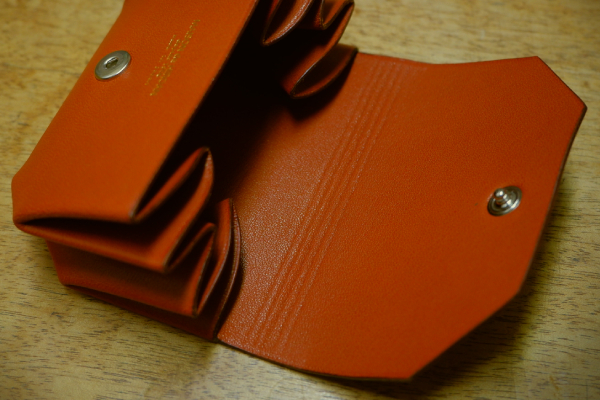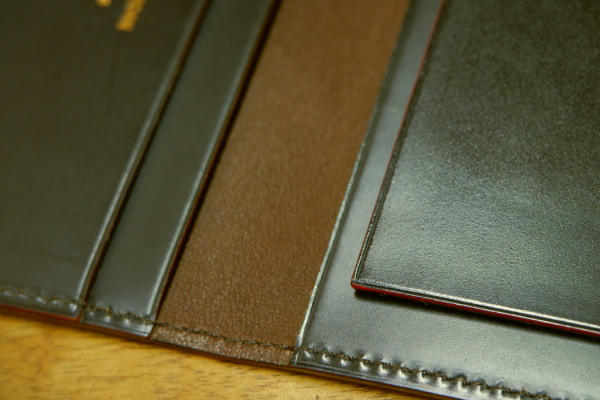

皮革製品の最高の贅沢と言われるこの技法は、あらゆる利点を兼ね備える。
それぞれの繊維方向の違う2枚を貼合わせることにより非常な堅牢度を示す。
従って極薄なものをつくり上げることができる。そして、まるで薄くスライスしたゴムの板の様な柔軟性が生まれる。
博庵は、ほとんどの製品に全面、もしくは必要部分にベタ貼り加工を施してある。

This technique is said to be the most luxurious for leather products, and carries all the benefits. Combining two sheets of leather with different fiber directions brings about extreme robustness. Therefore, it becomes possible to make a very thin product. Such product also has flexibility like a thinly sliced rubber plate. We use the full-bonding technique for almost all the products, either totally or partially, as required.

コバのミガキ

コバのミガキ
博庵の製品は"切り目"と呼ばれる手法がほとんどを占める。切り目とは、コバが裁断された姿で出来上がっている物。 しかし、裁断されたままでは製品と呼ぶにふさわしくない物になるため裁断面をミガキと呼ばれる処理加工を施す。この加工はその名の通りコバ面を実際に布によってミガキ上げるのである。
世に出回るほとんどの商品が、コバ面に塗料を塗布して仕上げる手法によるものである。博庵はあえてこのコバ処理に古来からの手法に依る染料にて着色し、その後コバミガキで仕上げている。 このコバミガキは非常に労力を要するため、世界的に観てほとんど行われていない。
ついでにもう一つ付け加えておこう。現在"本ミガキ"という言葉をよく耳にするが、本来"本ミガキ"という言葉は存在せず前述した塗料の塗布をミガキと間違えて呼ぶようになったので、実際ミガキをかけたものを本ミガキと呼ぶようになったのではないかと思われる。
We use a technique called "cut edge" for almost all the products. Cut edge means a sharp edge that leather has just 4after being cut. A leather product needs to have such a sharp edge processed by another technique called "polishing". As the name suggests, polishing uses a cloth to polish sharp edges, making them smooth. Almost all the leather products in the world have a different finish. They apply paint to edges to finish. On the contrary, we use a traditional technique: dye the edges and then polish them with a cloth to finish. Because this traditional technique requires a lot of labor, it is rarely performed around the world. Let us add one more thing. Currently, you often hear the words "Hon Migaki" (true polishing) instead of "Migaki" (polishing) . There is no such thing like true polishing, but it was devised because painting edges as described above began to be called "polishing" by mistake. So we guess people wanted to distinguish genuine polishing from 'polishing'.

ヘリの後切り
コバの処理には前述の切目があり、そして表革を内側に返すヘリ返しとがある。
博庵の商品は九分九厘切り目の手法を採っているが、内装に対してはヘリ返しがほとんどである。
このヘリ返しの際にヘリを返した後、ミシンの糸の際ギリギリに余分なヘリを裁断してヘリ幅を細くみせるという手法のことである。
この手法は古来ヨーロッパで育った手法であり日本には存在しないものである。
どんな巨匠と言われる画家であっても、キャンバスのまま壁に掛けたところで絵にはならないものである。
やはり素敵な額縁に入れない限り売り物にはならないであろう。
この額縁に博庵は着眼し、ヘリ切りの手法を採っている。

ヘリの後切り
In addition to cut edge, there is another technique to treat an edge called bagged edge in which the surface leather is turned inside. We use cut edge for almost all the products but for inner treatment, we use the bagged edge technique for almost all the cases. In this technique, after bagging an edge, the margin of the edge should be cut along the closest possible line to the stitching to make the edge look as thin as possible. This technique was originally developed in ancient Europe and it didn't exist in Japan. A painting even by a greatest master will be of little value if only the canvas is hung on the wall. As merchandise, it will not attract people unless it is decorated in a fine frame. We noted this idea of a frame and adopt the technique of edge cutting.

ネン引き

ネン引き
電熱ゴテでつけた、革の際の細幅のミゾをネンと呼びます。紳士用革財布の特徴的な装飾ですが、革包司博庵のネン引きは、 ヘリからきっかり1mm。目をこらさないと見えないかもしれませんが、このラインがあるとないとでは、財布の美しさがまったく変わります。革包司博庵では、全製品にこのネン引きを入れています。通常、ネンを引くコテは袋物屋専門の道具屋で売られていますが、コテ部分には医療用ステンレスを使い、さらに先端を極細のヤスリで削り出し、オリジナルで自作。祖父、父の言葉で今でもよく覚えている言葉があります。「いかに腕のよい職人だと言われようとも、必ず道具は使うであろう。要するによい職人と言われる所以は、いかに良い道具を創造できるかによる」と。道具は職人の命と捉え、財布づくりに向きあってきました。ネンのような細部にも一切手を抜きません。
We call the narrow groove made along the edge of the leather with a heated creasing iron “Nen.” This is a distinctive decorative feature of gentlemen’s leather wallets. At Kawahoushi HIROAN, our Nenbiki is applied precisely 1 mm from the edge. It may be barely visible at first glance, but this subtle line makes all the difference in the beauty of the wallet. We incorporate Nenbiki into every one of our products.
While creasing irons are usually purchased from specialist tool suppliers for bag makers, ours are crafted in-house. The iron tips are made of medical-grade stainless steel and meticulously refined to an ultra-fine point with a hand-filed finish. I still remember my grandfather and father’s words: “No matter how skilled a craftsman you are, you will always rely on your tools. A true craftsman is measured by how well they can create the best tools.”
At Kawahoushi HIROAN, we regard our tools as the lifeblood of our craft, continually creating and refining them to achieve the highest quality. We never compromise on details, even on something as subtle as Nenbiki.

一体裁断
二つ折りの財布に付属する小銭入れは、通常、「前段」と呼ばれる小銭を受ける面のパーツと、その両脇に取り付ける「マチ」と呼ばれるパーツを縫い合わせて作られていますが、革包司博庵では、前段とマチを一枚の型紙上で合体させ、それを1枚の革から切り出す一体裁断によって小銭入れを作っています。
枚革を折り曲げて作っているので両脇にミシン目がなく、そのことで見た目がスッキリするだけでなく、革の優美さが増幅され、高級感が保たれます。
しかも、一枚革であることで堅牢度も増すという、まさに一挙両得の技法。小銭を出し入れするたびに、一枚革の心地よい包容力を感じることもできるでしょう。
一体裁断はこのようによいことづくしである一方、型紙の取り方が非常に複雑。さらに、革のロス率も上げてしまうため、大半の財布はこの技法を用いていません。

一体裁断
In a typical bi-fold wallet, the coin pocket is made by sewing together a front panel, called the maedan (the part that receives the coins), with separate gusset pieces on each side. At Kawahoushi HIROAN, however, we combine the front panel and gussets into a single pattern and cut it from one continuous piece of leather using a technique called single-piece cutting.
Because the pocket is folded from a single sheet of leather, there are no stitches along the sides. This not only gives the wallet a clean and streamlined appearance but also enhances the elegance of the leather and preserves its sense of luxury. Moreover, the one-piece construction increases durability, making it truly a method of “two birds with one stone.” Each time you take coins in and out, you can feel the comforting embrace of a single piece of leather.
Despite its advantages, single-piece cutting requires extremely complex patterning and results in higher leather waste, which is why most wallets do not employ this method.